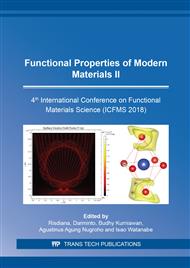p.3
p.8
p.14
p.19
p.25
p.30
p.35
p.41
The Morphology of Si-K-HAs Composite Prepared by Spray Drying
Abstract:
The silica potassium humic substance (Si-K-HAs) composite have been produce by spray drying successfully. In the previous study the preparation of Si-K-HAs gel by precipitation method required the addition of acid so that Si-K-HAs gel product contains acid salts. This study was develope spray drying method in order to eliminate the use of acid. The mixture of potassium silicate, cellulose and humic potassium solution was mixed with varying volume ratios and flowed into a spray dryer to produce Si-K-HAs powder. The used of cellulose (CMC) in this study acts as a homogeneous agent so that silica and humic substance can be completely mixed at controlled viscosity. Si-K-HAs products were characterized by Scanning electron microscopy (SEM), X-ray fluorescence (XRF), X-ray diffraction (XRD), Fourier transform infrared spectrometry (FTIR), and Surface area analytical (SAA). The result showed that the Si-K-HAs composite prepared by spray dryers have spherical particles, SiO2 in the range of 48-50%, K2O in the range of 49-50%. The present of cellulose caused the increasing of Si-K-HAs particle size e.g 17.30 μm prepared without CMC to 41.11 μm prepared with addition of 100g of CMC. The presence of cellulose can also increase the surface area of the spray-dried Si-K-HAs particles from 111.92 m2g-1; 163.241 m2g-1.
Info:
Periodical:
Pages:
19-24
Citation:
Online since:
August 2019
Authors:
Keywords:
Price:
Сopyright:
© 2019 Trans Tech Publications Ltd. All Rights Reserved
Share:
Citation:


